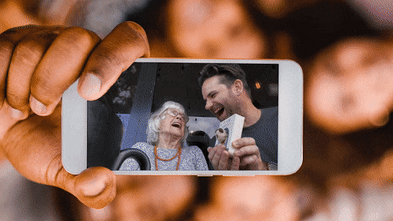For van Genderen, who has turned his phone clips into a documentary – Everybody’s Oma, which will be released in cinemas from August 11 – this was crucial. Because by the time van Genderen’s mother, Hendrika (nickname: Oma), moved in with him and his wife, Megan, and two young children in 2016, she was 84 and suffering from dementia and Alzheimer’s. She stayed for four and a half years before dying at 89 in February this year.
The film documents Hendrika’s decline and the bomb-blast impact it had on his family.
“It’s a huge cost to our little family, it’s a huge cost to our marriage,” Megan van Genderen says with a faltering voice at one point in the film, while she and her husband fight in their kitchen about how long Hendrika, who frequently falls and hurts herself and forgets where she is, can safely stay in their home. (For a while, the family was virtually unable to leave the house because Hendrika would become too distressed when left alone.)
“I felt guilty about the quality time that I wasn’t spending with them any more,” says Megan, over the phone, about her children, Evie and Artie, now aged three and six. “I don’t want you to go!” Artie cries in one scene to his mother, as she’s about to leave the house.
Being close to people physically is what helps build connection. Especially if you’re sort of huddled around a phone.
Clinical psychologist Mary Spillane
But it is these clips – in addition to sunnier ones like one of van Genderen’s family creating a grocery store in their kitchen for Hendrika to go “shopping”, which aired in part on the Late Late Show With James Corden and racked up more than nine million views online – that continue to aid the van Genderen children’s development, say their parents.
Seeing the film at its Sydney film festival premiere in June has helped Artie to grieve the loss of his grandmother, says the filmmaker. “He heard her [Oma] talking, he saw her in motion, that’s when it all solidified for him,” he says. “She’s actually really gone. She hasn’t just gone out. It was a really nice little bonding experience for Megan and I to nurture him through that.”
And being able to see the videos as they get older will likely help both children to understand what helped shape crucial parts of their personalities.
“There’s a level of compassion and patience in them that’s different because of what they’ve gone through, living with Oma,” says van Genderen of his children who, in the film, patiently show their grandmother how to play a card game and point to their lips to help her to understand what they’re saying. “They understand when someone’s doing it tough.” Without the videos, says Megan, Evie would be unlikely to remember her grandmother, or the time they shared.
And, says clinical psychologist Mary Spillane, watching videos of shared experiences can help all parents and children to bond, regardless of their family situation.
“Having that kind of shared time and shared interests with each other is good,” says Spillane. “There’s also an element of physical closeness of watching a video together. Being close to people physically is what helps build connection. Especially if you’re sort of huddled around a phone.”
Loading
For those parents who are having a tricky patch with their kids, perhaps during the teenage years or when small kids are going through a patch of tantrums, being able to watch a video of shared happier times can also be helpful.
“It’s called the recency effect; that the last thing you’ve seen can colour how you feel about someone,” says Spillane. “We often tend to, when we’re thinking about people or things that happened, it’s often the last thing that happened that we draw most meaning from. So if you’re looking at these videos of happier or [more] enjoyable times, then it’s likely to not only elicit positive emotions, but [inspire you to] reflect more empathetically or kindly about your child, particularly if it’s been difficult.”
This isn’t to say parents should encourage a screen free-for-all at home.
“There are problems with doing too much of anything,” says Spillane. “And in many respects we don’t fully understand the impacts [of screens]… But it’s about looking for these opportunities where they can actually be really useful.”
Now, three months after my mother’s death, I would give anything to have a video of some of my final conversations with her. I pine to hear what her voice sounded like when she looked over at me, the day before she died, and said: “I remember when I first saw you. Such a beautiful baby. Black hair.”
But I’m lucky. And not just because I’m kiss-the-ground grateful that, before my last visit to her, we managed to forgive each other for our inability to accept each other earlier. I also have the videos of my children uttering the last words they said to her, while gazing through the phone at her with kind, clear eyes. They remind me of who I’d like to be, more often.
Make the most of your health, relationships, fitness and nutrition with our Live Well newsletter. Get it in your inbox every Monday.
Stay connected with us on social media platform for instant update click here to join our Twitter, & Facebook
We are now on Telegram. Click here to join our channel (@TechiUpdate) and stay updated with the latest Technology headlines.
For all the latest Life Style News Click Here
For the latest news and updates, follow us on Google News.

